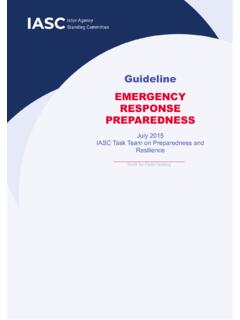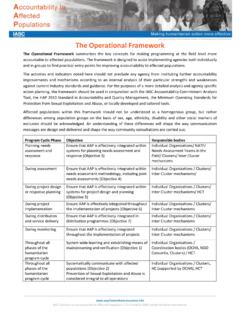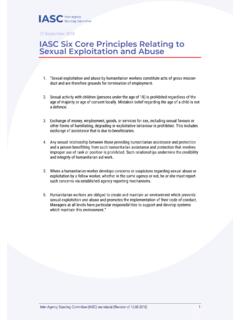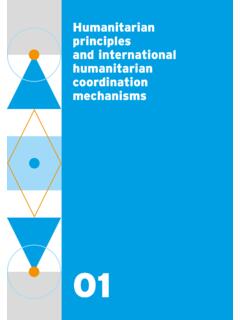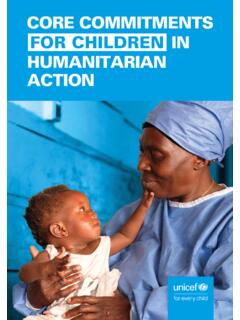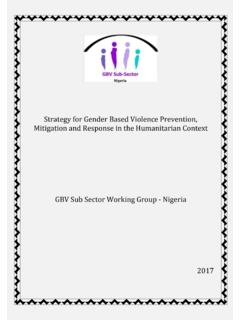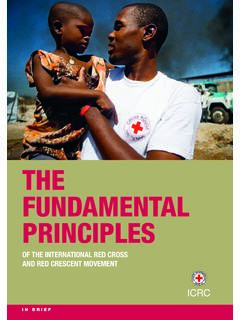Transcription of Guidelines THE GENDER HANDBOOK FOR HUMANITARIAN …
1 Guidelines THE GENDER HANDBOOK FOR HUMANITARIAN ACTION IASC Reference Group on GENDER and HUMANITARIAN Action February 2018 Endorsed by IASC PrincipalsThe GENDER Handbookfor HUMANITARIAN ActionInter-Agency Standing CommitteeInter-AgencyStanding CommitteeIASCI nter-AgencyStanding CommitteeIASCR eference Group for GENDER in HUMANITARIAN ActionInter-AgencyStanding CommitteeIASCI nter-AgencyStanding CommitteeIASCThe GENDER Handbookfor HUMANITARIAN ActionM' ' ' ' ' ' ' ' ' ' ' ' ' ' ' ' ' ' ' ' ' ' ' ' ' ' ' ' ' ' ' ' ' : ' ' ' ' ' I I Inter-Agency Standing CommitteeInter-AgencyStanding CommitteeIASCThe GENDER HANDBOOK for HUMANITARIAN ActionCopyright Inter-Agency Standing Committee (IASC) 2017. All rights document is issued for general distribution. Reproductions and translations are authorized, except for commercial purposes, provided the source is language versions of this IASC GENDER HANDBOOK for HUMANITARIAN Action can be obtained at the IASC GENDER website: / GENDER -and- HUMANITARIAN -action.
2 Agencies have the right to translate the HANDBOOK to other languages provided the IASC is acknowledged. This website also offers further resources on GENDER in HUMANITARIAN Group for GENDER in HUMANITARIAN ActionInter-AgencyStanding CommitteeIASCI nter-AgencyStanding CommitteeIASC3 The Inter-Agency Standing Committee (IASC) published the original Women, Girls, Boys and Men. Different Needs Equal Opportunities: GENDER HANDBOOK in HUMANITARIAN Action in 2006. The purpose of the HANDBOOK was to provide HUMANITARIAN actors with guidance on GENDER analysis, planning and actions to ensure that the needs, priorities and capacities of women, girls, men and boys are considered in all aspects of HUMANITARIAN response. The first edition predated the more recent HUMANITARIAN reform and Transformative Agenda processes and as such, did not reflect the current iteration of the sector system, the IASC GENDER Marker, the HUMANITARIAN Programme Cycle and other advances in HUMANITARIAN coordination, leadership, accountability and partnership.
3 After wide consultations with IASC members, sector leaders, field users and donors, the GENDER HANDBOOK has been updated. The revised version is a concise guide built upon lessons learned by the HUMANITARIAN community and reflects the main challenges faced in ensuring that GENDER is adequately integrated into HUMANITARIAN planning and programming. The HANDBOOK is complemented by detailed information found in the regularly updated online platform. The review of the HANDBOOK was undertaken by the IASC GENDER Reference Group in 2016. It was endorsed by the IASC to meet collective commitments on GENDER equality in HUMANITARIAN action. The GENDER HANDBOOK for HUMANITARIAN ActionAll-new Second EditionForeword4 Monique Pariat, Director-General, Directorate-General for European Civil Protection and HUMANITARIAN Aid Operations (ECHO), European Commission 5 Natural and man-made crises have a different impact on women, girls, boys, men.
4 The European Union is committed to ensuring that all its HUMANITARIAN aid operations integrate GENDER and age, as a matter of quality and effective programming. I am therefore pleased that the European Union, through its Directorate-General for European Civil Protection and HUMANITARIAN Aid Operations (DG ECHO), has supported this timely revision of the 2006 version of the Inter-Agency Standing Committee (IASC) GENDER HANDBOOK for HUMANITARIAN Action. This HANDBOOK usefully stresses that ensuring that all people affected by crisis are reached with a needs and capacities-adapted response is a matter of quality and effective programming, and is no longer a negotiable requirement for HUMANITARIAN actors. Integrating GENDER considerations into HUMANITARIAN programming contributes to enhancing access to assistance.
5 By fostering meaningful participation of women, girls, men and boys, we can design our responses better. Affording protection to all groups in vulnerable situations must be a cornerstone of our efforts. We all need to do more to prevent and mitigate protection risks and ensure that adequate responses are provided. I hope that this HANDBOOK will become an international resource that contributes to this work. With the finalization of this review of the HANDBOOK , HUMANITARIAN actors now have a comprehensive package of guidance on GENDER mainstreaming and on addressing and preventing GENDER -based violence at their disposal: the IASC GENDER HANDBOOK , the IASC Guidelines for Integrating GENDER -based Violence Interventions in HUMANITARIAN Action, as well as the upcoming revised IASC GENDER -Age Marker.
6 I urge all HUMANITARIAN actors to make use of these important tools; their complementarity and interplay can make a significant contribution to ensuring that the needs of women, girls, men and boys are taken into consideration at all stages of HUMANITARIAN relief operations. Let me end by stressing that integrating GENDER in HUMANITARIAN action is a shared responsibility. It is a responsibility for all HUMANITARIAN aid workers, no matter what sector they work on. It is my hope that this HANDBOOK , which provides practical guidance on integrating GENDER into 11 sectors, will help fulfil this Pariat6 Mark Lowcock, Under-Secretary-General for HUMANITARIAN Affairs and Emergency Relief Coordinator Foreword7 Around the world, armed conflicts and natural disasters are exacting a massive toll on the lives of millions of people.
7 In each and every one of these HUMANITARIAN crises, we know that women and girls are affected differently than men and boys, and that vulnerabilities are often exacerbated by other factors such as age, disability, sexual orientation, ethnicity or religion. GENDER equality and the empowerment of women and girls are at the very core of principled and effective HUMANITARIAN action. As humanitarians, it is our fundamental responsibility to protect and promote the rights of all people we serve. To this end, we need to understand the specific needs, capacities and priorities of women, girls, boys and men, and integrate this understanding throughout the programme cycle. It also means we must facilitate the active participation and leadership of women and girls in HUMANITARIAN action and beyond; and promote transformative change for more inclusive and equitable societies.
8 On behalf of the Inter-Agency Standing Committee (IASC), I am pleased to present this updated version of the GENDER HANDBOOK in HUMANITARIAN Action. It is an important resource that will help HUMANITARIAN actors build on IASC commitments on GENDER equality and women and girls in HUMANITARIAN action, with the aim of delivering more effective, rights-based programming. The HANDBOOK offers practical guidance to ensure that GENDER equality and women s empowerment are mainstreamed throughout the assessment, planning, resource mobilization, implementation and monitoring stages of the HUMANITARIAN programme cycle. On behalf of the IASC, I would like to extend our appreciation to everyone involved, across many organisations, for their considerable investments in both capital and human resources towards the development of this new GENDER HANDBOOK for HUMANITARIAN Action.
9 As the HUMANITARIAN community moves forward in its shared responsibility to leave no one behind, I am sure this HANDBOOK will be an instrumental resource for partners around the world. Mark Lowcock8 AcknowledgementsThe review of the 2006 version of this HANDBOOK was initiated by the IASC GENDER Reference Group and led by UN-Women and Oxfam, with substantive contributions from a multi-stakeholder Steering Committee comprising representatives of CARE, GenCap, InterAction, OCHA, UNFPA, UNHCR, WFP, WRC and DG ECHO as an observer. This update of the HANDBOOK was supported by funding from the European Commission s Directorate-General for European Civil Protection and HUMANITARIAN Operations (ECHO), and with co-funding from the Swedish International Development Cooperation Agency, a quest to make it practical and user-friendly, this revised edition of the IASC GENDER HANDBOOK benefits from the feedback of more than 250 stakeholders worldwide including: government entities; donors; United Nations agencies and sectors; and international and national non-governmental and civil society organizations, including the Red Cross movement.
10 Additionally, technical contributions were provided by members of the sector leadership system of the IASC and a host of GENDER specialists. More specifically, the following agencies and organizations contributed to the development of the IASC GENDER HANDBOOK . This updated version contributes to GENDER equality and women s empowerment programming and outcomes in HUMANITARIAN action around the for European Civil Protection and HUMANITARIAN Aid OperationsFood and Agriculture OrganizationHelpAgeInteractionInter-Agen cy Standing CommitteeIASC GenCap ProjectInternational Committee of the Red CrossInternational Federation of the Red Cross and Red Crescent SocietiesInternational Organization for MigrationInternational Rescue CommitteeNorwegian Refugee CouncilUnited Nations Office for the Coordination of HUMANITARIAN AffairsOffice of the United Nations High Commissioner for Human RightsOxfamSwedish International Development Cooperation Agency (Sida)
